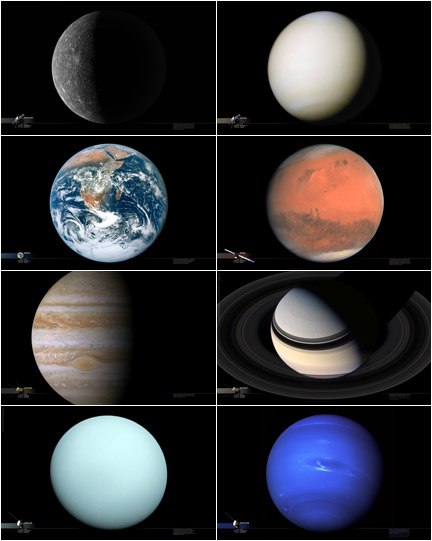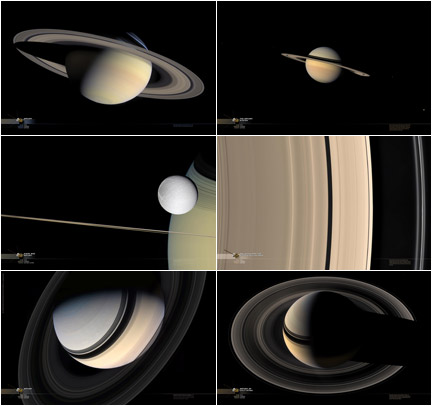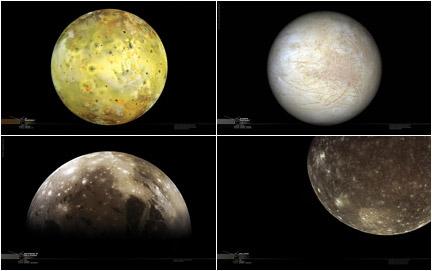Wallpapers: The Martian Ganges Chasma
 The Ganges Chasma is a side canyon at one end of the vast Valles Marineris trough system of Mars. This image was returned by ESA’s Mars Express, brought to our attention by Bill Dunford’s Riding with Robots. The image above is a 2560x1800 wallpaper. Download the 1440x900 here.
The Ganges Chasma is a side canyon at one end of the vast Valles Marineris trough system of Mars. This image was returned by ESA’s Mars Express, brought to our attention by Bill Dunford’s Riding with Robots. The image above is a 2560x1800 wallpaper. Download the 1440x900 here.
Wallpaper 2560x1600 Set 03: The Planets
The planets – the complete set for collectors! While there are literally thousands of images of the planets to choose from… full globe high resolution images are actually fairly rare. They usually require many exposures to be stitched together to make one large complete image. This is not only difficult to work out across the great distances of space, but also soaks up a large amount of valuable spacecraft time and energy. This set represents the best available images of each planet in our Solar System.

Sorry, no Pluto for more than one reason.
2560 x 1600 Set 05 : Saturn Scenes
Among the various worlds in our celestial neighborhood, Saturn stands apart as a most photogenic. With the help of a complex system of rings it naturally lends itself to more scenic images as compared to the more detail oriented images we see from such other places such as Mars or Jupiter. The “Saturn Scenes” set (downloadable here as a zipped file) was compiled from some of the best scenic images from the Cassini mission that had the potential to fill a 2560x1600 frame.

In order to completely fill that frame out some rendering and sampling has been applied to the original images. These additions are briefly noted in the images themselves and are as noted here…
DIONE AND SATURN features the moon Dione passing in front of the edge of Saturn’s disc. The original image would only fill about 1/4 of the frame so some of the details have been sampled and expanded to fill out that full frame’s proportions. The details of the rings are sampled from this image and based upon other photographic references. The left 2/3 of the rings seen here were rendered and are not actual. The lower 1/5 of Saturn’s disc was sampled and extended from the original image. Lastly, the top darkest ring shadows were rendered based upon a fair amount of actual data that was actually present in the original but was cropped short.
SATURN (which is named “SATURN-2.jpg” in the file name) has had a considerable amount of rendering to extend the details of the rings to fill out this larger 2560x1600 frame. The original color composite work was masterfully performed by Ian Regan for unmannedspaceflight.com and has become a wanderingspace favorite. In order to extend the rings to fill out the frame as accurately as possible, a one pixel wide sampling of the full set of rings was captured and digitally translated to vectors. These vectors were then stretched and applied to a circle path which was then rendered in 3-D software to achieve the correct perspective of the original. Once a match was made, the new vector based rings were then blended into the actual original image and some masking was applied to represent Saturn’s shadow falling upon the rings. Despite the heavily rendered nature of the rings, virtually no part of the disc of Saturn itself has been altered and is 99.5% original and actual.
All other images are actual and unaltered.
2560 x 1600 Set 02 : The Moons of Jupiter
The moons of Jupiter (well, the 4 major ones) are in their own right, a Solar System within a Solar System. There is volcanically explosive Io; Europa with its cracks and ridges hinting at its huge internal ocean; Ganymede the largest moon in our celestial neighborhood and Callisto one the most heavily cratered bodies we have anywhere. The 4 moons are also called the Galilean moons as they were discovered by Galileo and have since been revealed to be more fascinating than most planets are. The images below represent what I think are likely the best representative images of these places that can fill a 2560x1600 screen. At this size, the details are quite impressive… do take a look even if you can’t make use of the images as wallpaper images.
The Europa image is actually a render created by Tayfun Öner as not that many satisfactory images exist of a full globe Europa. Many great images exist of Ganymede but most are low resolutions, this image was stitched together by Ted Stryk of www.unmannedspaceflight.com. The other two are officially released NASA composites.

